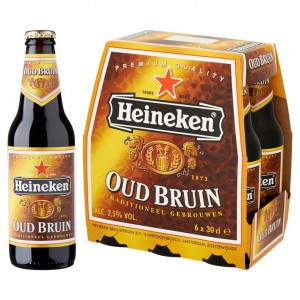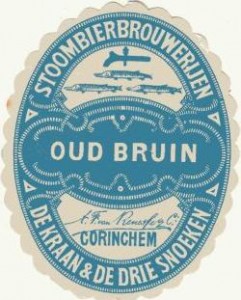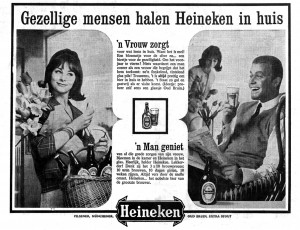Oud bruin: a tale of two beers
 And now, let’s talk about the least known Dutch beer type: oud bruin. You won’t see it in fancy beer pubs, or at craft beer festivals. The most likely place where you’ll find it, is the highest shelves in the supermarket. It’s hard to find anyone who actually likes this ‘old brown’, a low-alcohol beverage that tastes like diet coke. A sweetened, weak, bottom-fermented 2,5 ABV dark beer. What on earth is to be said of such a depressingly plain drink?
And now, let’s talk about the least known Dutch beer type: oud bruin. You won’t see it in fancy beer pubs, or at craft beer festivals. The most likely place where you’ll find it, is the highest shelves in the supermarket. It’s hard to find anyone who actually likes this ‘old brown’, a low-alcohol beverage that tastes like diet coke. A sweetened, weak, bottom-fermented 2,5 ABV dark beer. What on earth is to be said of such a depressingly plain drink?
Well, at least something. The oldest mention I found of ‘oud bruin’ was in the city of Rotterdam, where Bierhuis Nederlands Nijverheid (‘Beer House Dutch Industry’) sold it in 1834.[1] That early? It must have been top-fermenting then. Throughout the 19th century Dutch breweries have been producing oud bruin, but only the old-fashioned top-fermenting breweries. Not the modern ‘Bavarian style’ newcomers like Amstel and Heineken, who are the ones producing it nowadays.
What sort of beer was this oud bruin then? An 1891 advert for the Hopbloem (‘Hop flower’) brewery from Gorinchem gives an indication. This ‘Delicatessen brewery’ advertised its ‘Old Brown beer, heavy and matured, at least as strengthening as matured Wine, can compete with all other beer types, powerful, tasty, clear and chemically tested.’[2] Hm, that does sound different than the Heineken soda pop-like oud bruin I got from the supermarket the other day.
 In 1857 G.J. Mulder (no relation) of Utrecht University did some research on beer, and in his book he gives some data of Utrecht beers. They were a bit weak (not as much extract as English and German beers) but ‘not rejectable’. Mulder also mentions the amount of acid (lactic and acetic acid) the beers contained. Not surprisingly, the two Lambics brewed in Utrecht contain the most acid, but the Oud Bosch beer from the city of Den Bosch and the oud bruin from the Boog (‘Bow’) brewery in Utrecht were hardly less acetic.[3]
In 1857 G.J. Mulder (no relation) of Utrecht University did some research on beer, and in his book he gives some data of Utrecht beers. They were a bit weak (not as much extract as English and German beers) but ‘not rejectable’. Mulder also mentions the amount of acid (lactic and acetic acid) the beers contained. Not surprisingly, the two Lambics brewed in Utrecht contain the most acid, but the Oud Bosch beer from the city of Den Bosch and the oud bruin from the Boog (‘Bow’) brewery in Utrecht were hardly less acetic.[3]
Okay, so the 19th century oud bruin must have been quite sour. A further indication on the nature of oud bruin is given by the aforementioned Hopbloem brewery in Gorinchem, though involuntarily. In 1892 this brewhouse went bankrupt, after only seven years of existence. And what do we see at the execution sale? An offer of eighty hogsheads of ‘Excellent Old Beer, brewed in the years 1885 to 1890’.[4] Why would a brewery store all this old beer? The answer seems obvious: to make oud bruin with it.
It is also not unthinkable that this beer, matured in vats for a few years, was blended with fresh beer, just like in Maastricht where they made Mestreechs Aajt (‘Maastricht Old’). And not unlike today’s Flemish old brown and red beers like Rodenbach and Duchesse de Bourgogne. After all, these are still called ‘oud bruin’ too! Unfortunately, data on how exactly the Dutch old beers were ripened and blended are still rare. The only thing I do know, is that these old beers don’t exist anymore.
Oud bruin had the same fate as all the other old-fashioned top-fermenting Dutch beer types: they became extinct. In 1889 the Algemeen Handelsblad newspaper claimed that the people of Breda ‘remained attached to the favourably known Breda’s old brown beer (top-fermenting method) rather than the so-called Bavarian Lager’ but after the First World War there was only one brewery left that made oud bruin: De Krans in Utrecht.[5] When they had to close in 1930, Dutch oud bruin had disappeared completely.
Or had it? Where does today’s overly sweet stuff with the same name come from? The answer lies in the First World War. Already the big bottom-fermenting brewers produced quite a lot of cheap dark lager, but when the grain shortage of 1918 came, those breweries had to abandon their heavier beers like Pilsener and Munich Dark altogether. Instead, they made only ‘Light lager’ and ‘Dark lager’, weaker and with less alcohol.
After the war, these beers were kept in production. Deliberately, because they filled a niche in the market, especially in the South of the Netherlands. In the provinces of North Brabant and Limburg there were still many small and often traditional breweries. Big lager brewers like Amstel and Heineken still had a lot of territory to conquer there. Also, the national beer consumption was steadily declining, in the years 1928-1937 it halved![6] The Amsterdam breweries therefore needed to get access to the market in the South. In the South, the public was often still used to old-fashioned, sweet top-fermented beers with not a lot of alcohol. So how to compete with this? By adding a load of sugar to the bottom-fermented Dark Lager. Easy. The new Oud bruin was born.
One of the first breweries to introduce this new Oud Bruin was Amstel in July 1935.[7] Other bottom-fermenting beer factories like Heineken, Van Vollenhoven and ZHB from The Hague followed suit. Pilsener beer was already popular nationwide, but those stubbornly drinking the last top-fermenting rarities could now switch to sweetened and diluted dark lager.
A weak beer like oud bruin had no difficulty surviving the Second World War and after the liberation it was immediately back on sale, as ‘Pre-war’ quality. And while Amstel deliberately discontinued Light Lager in favour of Pilsener, and though Dark Lager fell from favour too, Oud Bruin continued to sell. The only problem was the original targeted demographic: elderly drinkers of old-fashioned beer types. Luckily, a new target audience was found for Oud Bruin: women.
 In the 1950 and 1960 this led to a massive amount of wonderfully patronising adverts. Clearly, in those days a woman was not expected to actually like beer. She was however supposed to go and get it in the supermarket for her husband. If possible, she also had to open the bottle, pour the beer and serve it, while he was sitting comfortably by the central heating, with pipe, slippers and newspaper. ‘Why don’t you taste a sip of your husband’s beer, Madam, you will surely love it because Oud Bruin really is a treat!’ the Oranjeboom brewery cheered in 1957.[8]
In the 1950 and 1960 this led to a massive amount of wonderfully patronising adverts. Clearly, in those days a woman was not expected to actually like beer. She was however supposed to go and get it in the supermarket for her husband. If possible, she also had to open the bottle, pour the beer and serve it, while he was sitting comfortably by the central heating, with pipe, slippers and newspaper. ‘Why don’t you taste a sip of your husband’s beer, Madam, you will surely love it because Oud Bruin really is a treat!’ the Oranjeboom brewery cheered in 1957.[8]
The best ones are the Heineken adverts from the early 1960s. ‘Yes, you too Madam! Your husband will enjoy it if you join him with a glass of Heineken Pils. It’s modern. Or do you prefer a sweeter beer? No problem! Try a Heineken Oud Bruin!’ Or: ‘There’s nothing a man appreciates as much as a woman who understands what he is entitled to: a twinkling, sparkling glass of pils! … It looks so generous and welcoming when you have visitors. (Tip: why don’t you try a glass of Oud Bruin yourself.)’ Those happy days, where have they gone..?[9]
However, when emancipation came round, women started drinking pilsener and all those other heavier beers that men like too. Oud bruin, lowered in alcohol content by Heineken from 3.5 to 2.5% ABV in the 1970s, now sits a bit lonely on the supermarket shelves. It’s still used as a mixing drink in the province of Limburg (together with pilsener, it makes ‘sjoes’), but otherwise it seems like the days of this 1935 Dutch invention are numbered.[10]
[1] Rotterdamsche courant 6-5-1834.
[2] Het nieuws van den dag 12-11-1891.
[3] G.J. Mulder, Scheikundige verhandelingen en onderzoekingen, deel 1 nummer 3, Rotterdam 1857, p. 316.
[4] Nieuwe Gorinchemsche Courant 4-2-1892.
[5] Algemeen Handelsblad 22-2-1889.
[6] Peter Zwaal en Peter de Brock, Amstel, het verhaal van ons bier, Amsterdam 2010, p 83.
[7] Zwaal en de Brock, Amstel, p 88.
[8] Nieuwsblad van het Noorden 15-8-1957.
[9] Algemeen Handelsblad 10-5-1963, 3-7-1964.
[10] This article was based on an earlier version in Dutch, http://verlorenbieren.nl/verloren-bieren-18-oud-bruin-1/ and http://verlorenbieren.nl/verloren-bieren-18-oud-bruin-2/.






Leave a Reply